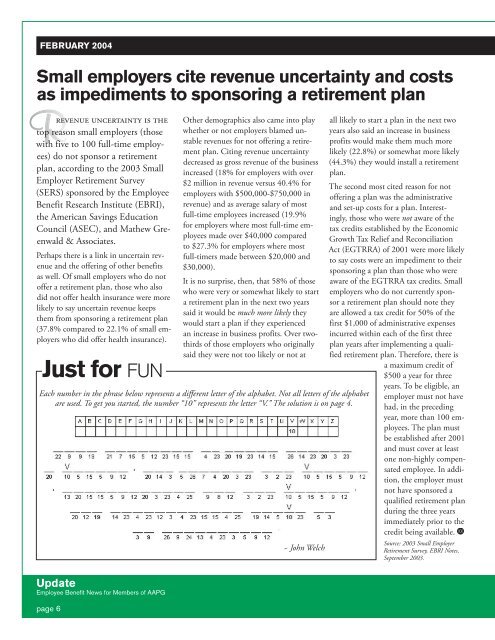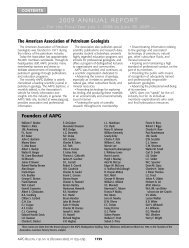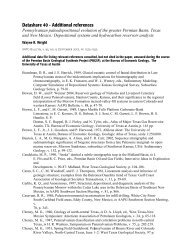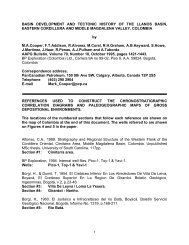S All asset categories end 2003 with positive returns - American ...
S All asset categories end 2003 with positive returns - American ...
S All asset categories end 2003 with positive returns - American ...
You also want an ePaper? Increase the reach of your titles
YUMPU automatically turns print PDFs into web optimized ePapers that Google loves.
FEBRUARY 2004<br />
Small employers cite revenue uncertainty and costs<br />
as impediments to sponsoring a retirement plan<br />
R<br />
revenue uncertainty is the<br />
top reason small employers (those<br />
<strong>with</strong> five to 100 full-time employees)<br />
do not sponsor a retirement<br />
plan, according to the <strong>2003</strong> Small<br />
Employer Retirement Survey<br />
(SERS) sponsored by the Employee<br />
Benefit Research Institute (EBRI),<br />
the <strong>American</strong> Savings Education<br />
Council (ASEC), and Mathew Greenwald<br />
& Associates.<br />
Perhaps there is a link in uncertain revenue<br />
and the offering of other benefits<br />
as well. Of small employers who do not<br />
offer a retirement plan, those who also<br />
did not offer health insurance were more<br />
likely to say uncertain revenue keeps<br />
them from sponsoring a retirement plan<br />
(37.8% compared to 22.1% of small employers<br />
who did offer health insurance).<br />
Just for FUN<br />
Update<br />
Employee Benefi t News for Members of AAPG<br />
page 6<br />
Other demographics also came into play<br />
whether or not employers blamed unstable<br />
revenues for not offering a retirement<br />
plan. Citing revenue uncertainty<br />
decreased as gross revenue of the business<br />
increased (18% for employers <strong>with</strong> over<br />
$2 million in revenue versus 40.4% for<br />
employers <strong>with</strong> $500,000-$750,000 in<br />
revenue) and as average salary of most<br />
full-time employees increased (19.9%<br />
for employers where most full-time employees<br />
made over $40,000 compared<br />
to $27.3% for employers where most<br />
full-timers made between $20,000 and<br />
$30,000).<br />
It is no surprise, then, that 58% of those<br />
who were very or somewhat likely to start<br />
a retirement plan in the next two years<br />
said it would be much more likely they<br />
would start a plan if they experienced<br />
an increase in business profits. Over twothirds<br />
of those employers who originally<br />
said they were not too likely or not at<br />
Each number in the phrase below represents a different letter of the alphabet. Not all letters of the alphabet<br />
are used. To get you started, the number “10” represents the letter “V.” The solution is on page 4.<br />
~ John Welch<br />
all likely to start a plan in the next two<br />
years also said an increase in business<br />
profits would make them much more<br />
likely (22.8%) or somewhat more likely<br />
(44.3%) they would install a retirement<br />
plan.<br />
The second most cited reason for not<br />
offering a plan was the administrative<br />
and set-up costs for a plan. Interestingly,<br />
those who were not aware of the<br />
tax credits established by the Economic<br />
Growth Tax Relief and Reconciliation<br />
Act (EGTRRA) of 2001 were more likely<br />
to say costs were an impediment to their<br />
sponsoring a plan than those who were<br />
aware of the EGTRRA tax credits. Small<br />
employers who do not currently sponsor<br />
a retirement plan should note they<br />
are allowed a tax credit for 50% of the<br />
first $1,000 of administrative expenses<br />
incurred <strong>with</strong>in each of the first three<br />
plan years after implementing a qualified<br />
retirement plan. Therefore, there is<br />
a maximum credit of<br />
$500 a year for three<br />
years. To be eligible, an<br />
employer must not have<br />
had, in the preceding<br />
year, more than 100 employees.<br />
The plan must<br />
be established after 2001<br />
and must cover at least<br />
one non-highly compensated<br />
employee. In addition,<br />
the employer must<br />
not have sponsored a<br />
qualified retirement plan<br />
during the three years<br />
immediately prior to the<br />
credit being available.<br />
Source: <strong>2003</strong> Small Employer<br />
Retirement Survey, EBRI Notes,<br />
September <strong>2003</strong>.















